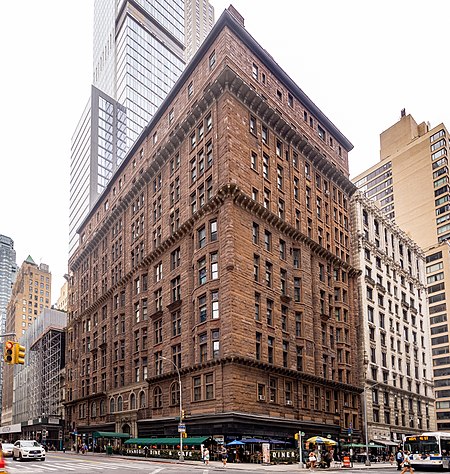Osborne Apartments

The Osborne, also known as the Osborne Apartments or 205 West 57th Street, is an apartment building at Seventh Avenue and 57th Street in Midtown Manhattan in New York City. The Osborne was originally designed by James Edward Ware and constructed from 1883 to 1885. An annex to the west, designed by Alfred S. G. Taylor and Julian Clarence Levi, was constructed in 1906. The Osborne is the second-oldest luxury apartment building in New York City, behind the Dakota. The Osborne's facade is clad in rusticated blocks of brownstone, with a main entrance on 57th Street and a variety of window configurations. The first floor has an elaborate foyer and lobby, while the other floors contain apartments in duplex arrangements. The southern section of the building, facing 57th Street, is 11 stories tall and originally contained main living spaces with high ceilings. The northern section, at the rear of the building, is 15 stories tall and contained the bedrooms and servant's rooms. The Osborne was originally built with 38 apartments, although many of these units were gradually subdivided starting in the early 1920s. The building's namesake was the stone contractor Thomas Osborne, who had acquired the land in 1883 from restaurateur John Taylor, constructing the building as a speculative investment. The $2 million construction cost forced Thomas Osborne into foreclosure, leading Taylor's family to acquire the building in 1889. The Taylors sold the Osborne in 1961, and it was turned into a housing cooperative the next year. Throughout its history, the Osborne has housed many artists, actors, and musicians, as well as upper-middle-class residents such as doctors and lawyers. The New York City Landmarks Preservation Commission designated the building as a city landmark in 1991, and it was added to the National Register of Historic Places in 1993.
Excerpt from the Wikipedia article Osborne Apartments (License: CC BY-SA 3.0, Authors, Images).Osborne Apartments
West 57th Street, New York Manhattan
Geographical coordinates (GPS) Address External links Nearby Places Show on map
Geographical coordinates (GPS)
| Latitude | Longitude |
|---|---|
| N 40.765833333333 ° | E -73.980277777778 ° |
Address
Osborne Apartment House
West 57th Street 205
10019 New York, Manhattan
New York, United States
Open on Google Maps









